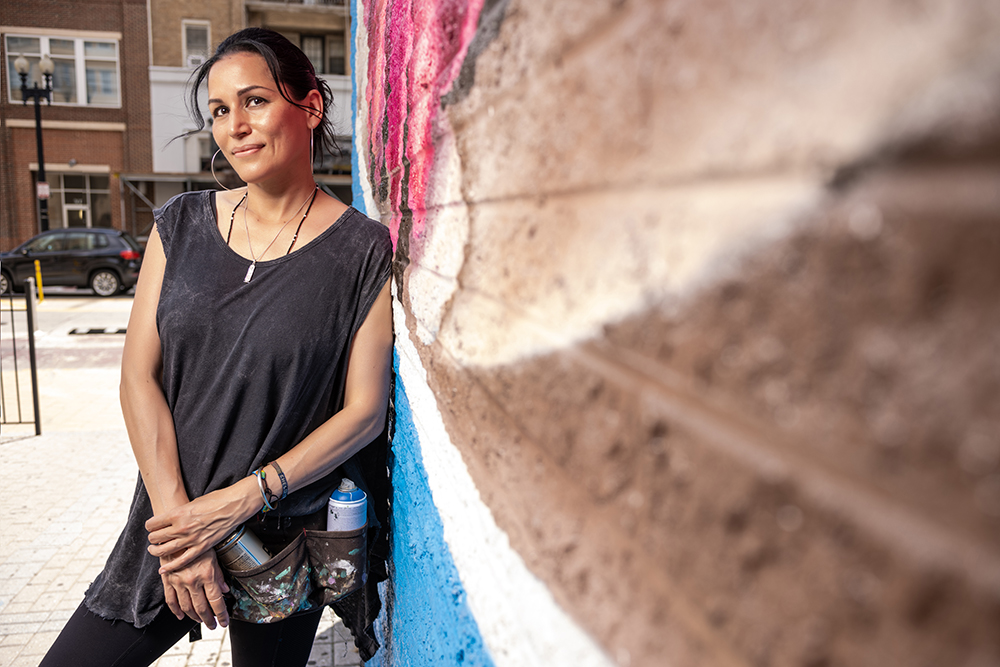Culture
 Cita Sadeli // MISS CHELOVE. Photo by Jonathan Thorpe.
Cita Sadeli // MISS CHELOVE. Photo by Jonathan Thorpe.
Artist MISS CHELOVE Creates for a Purpose
July 9, 2021 @ 10:00am
“So much of my essence is in the streets, and so much of the streets’ essence is in me.”
The streets Cita Sadeli is speaking of belong to the nation’s capital, the place she’s called home since age four and has a sometimes complicated, always loving relationship with. The artist knows D.C. the way only a native can. Each mention of a city block or street corner unravels a series of pithy stories and fond recollections of the city’s ever-evolving, often transformational arts community.
An hour with Sadeli is like taking a crash course in what has made the District cool over the past several decades. Every DIY punk space, underground go-go club, bohemian artist collective, graffiti-tagged wall or other creative nook is one she’s experienced, explored, embraced, supported, mourned the loss of and encouraged the rebirth of since the ‘80s. She views so much of the city’s arts scene as cyclical, a poetic timeline of ebbs and flows that always seem worth riding the tide for.
Sadeli, better known to most as MISS CHELOVE, is a muralist, art director, designer and illustrator who has built her career traversing and beautifying the quadrants of her beloved community. She navigates the tightrope so many authentic creators in D.C. try to, gracefully accepting gentrification while also keeping a fierce grip on what makes this city worth remaining in.
“There’s just so many chapters,” she says. “There’s a memory everywhere for me of something that’s happened before or something I did before. Nothing compares to the place where you grew up. D.C. will always be my home. It has my heart, for all of its faults and changes.”
She speaks with pride about the city’s graffiti artists pioneering the form and inspiring up-and-coming creators in the ‘80s when the punk movement was in full force, as well as the burgeoning street music scene and go-go’s pivotal role as the sonic backbone of our city. Sadeli walks me through the city’s steadfast political activism and artistic entrepreneurship at bustling collectives and interactive studios before seamlessly pivoting to the resources and infrastructure that now exist for makers of public art. D.C.’s artistic presence is unwavering, though the needs of the community continue to shift, as do the ways creators choose to express themselves and build connections.
“With D.C. being positioned as a very international and political city, so many people are coming here to participate in actions and protests. It makes our town really unique in that way, especially when you add the intersection of art and especially when you add the intersection of graffiti art. It doesn’t follow the rules. It’s very raw.”
When you add all of these elements together, she says, we have something other cities do not. We are a powder keg at the intersection of art and social justice. She recalls last summer’s uprisings around racial unrest, how walls were erected and canvases were filled by locals of all ages and backgrounds eager to express themselves artistically.
“It was a really cool sort of egalitarian experience where it didn’t matter who you were, where you came from or how much experience you had. You were out there speaking your truth and it was resonating with so many people. It’s just so interesting to see the cycles of us expressing ourselves with art, and becoming a venue for anyone who wants to come and create art for a purpose.”
Sadeli speaks openly about how she selects her murals, pausing several times to share examples of moments she’s had to be direct with potential clients — sometimes to the point of discomfort — about why a project isn’t the right fit for her. She’s quick to recommend other artists so as not to leave them in the lurch, though, and firmly stands her ground when saying she will always be honest with them about why she needs to turn it down.
She says providing no explanation is just rude, like declining an invitation to a party with no reason as to why. The artist has integrity, using these conversations as opportunities to educate people who may not understand or feel the reverberations of a culturally insensitive topic or a theme that might not resonate with multigenerational residents.
“It’s a hard discussion to have,” she says. “It can spark a lot of emotions with clients, but so be it.”
The artist says that without a doubt, the most meaningful projects to her are the ones centered on connecting with real people around real issues in support of the D.C. community. She does not associate herself with inaccessible or upsetting content — no exceptions.
“How can we use art to create connection and a healing space for frustration and anger, but also dialogue, discourse and solutions? It makes D.C. so explosive in that way. There’s so many opportunities, especially overlapping with the dismantling of all of these structural systems. It’s a very interesting time to be in this city.”
The OG
After getting to know Sadeli a bit, I’d argue that it’s always been an interesting time to be in this city — if you’re embracing it the way she has. Not only has she tapped into every underground scene and cultural renaissance we’ve experienced over the past four decades, she also continues to seek out the ways D.C. reinvents itself and carve out a safe and welcoming space for up-and-comers and fellow artists. As many of her peers have told me, “She’s the OG.”
The Silver Spring, Maryland resident was born in Indiana, where her mother was attending Indiana University after winning a Fulbright scholarship. Four years later, her mom — who raised her and her three older siblings on her own — relocated to Prince George’s County in Maryland.
“[We had a] really cool house in Hyattsville,” she says of her childhood home, one of the city’s oldest houses. “[I had a] very artsy, very loose, very free, very cool upbringing.”
Her family dynamic lent itself well to creative freedom and the ability to embrace her cultural roots. She credits her exposure to the punk rock scene at an early age with giving her a DIY ethic that taught her how to navigate the world.
“I’m still like that,” she says. “It’s about the work. It’s about the craft. The joy of making on a very grassroots level is something that’s really important to me, and really became ingrained in my being.”
She says growing up with a single mother and having limited resources taught her how to make do with what she had.
“With graffiti, that really inspired me to be very brave and paint really large. There’s a visual form and flow that’s still in my work. It’s still very important to me, and I’m actually getting back into it a little bit. I’m kind of having a little personal revival with graffiti, which is great.”
What feels like a spoken-word love letter to graffiti pours from Sadeli as she opens up about what the art form means to her. She speaks with a quiet fervor that draws you in; it’s subtle, yet captivating.
“It’s so inspiring: what new ideas you can create from all of these different things. It’s a super cool way to learn about color, art, form, typography. So many graphic design and fine art basics can be learned through the practice of graffiti. It’s beautiful.”
She says what D.C. really needs is an open wall where city artists can go legally and practice, and younger graffiti writers can learn from the OGs.
“It’s very much a hierarchical system where you’re coming in, you’re invited to a crew and you’re learning how to do all of these things from a very rudimentary level. [We need to] invite more women and girls, and equalize on that level more. I think it would be really great if we had a space like that in D.C., and I think it would be a great outlet for folks and a great training ground for young artists.”
She emphasizes the importance of mentorship, something she says she’s never really had and secretly still wants. When she was coming up, seeking out a mentor wasn’t something she understood how to do. But looking back, she wishes she hadn’t isolated as much as she had. To the up-and-comers, she recommends keeping an open collaboration and channel of communication with the community.
“The best thing you can do is try not to do everything yourself. You have to include other people. When I’m having a crazy day, I need someone to talk me off the ledge. I just need to express something and [get] feedback real quick. Something that simple is really key.”
Beyond that, she says you just have to put in the work. After all, you can’t do three sit-ups and expect a six-pack. She describes her muralist community as being full of super hard workers.
“I always like to connect it back to having an immigrant upbringing, where you saw someone working so hard [who] just didn’t have a choice. We have goals here that we need to reach. We don’t have a lot of people to help out. You have to be scrappy. The constant honing of the craft [and] that thirst for wanting to master this thing, but having fun along the way — that’s key.”
The impact of Sadeli’s immigrant upbringing extends beyond the work ethic her mother instilled in her to the palpable presence of spirituality and mysticism she has felt when visiting Java, the island her family is from in Indonesia.
“In our culture, there’s this reverence for the forces of nature, so that’s what I try to channel and turn over in my mind: ‘What does that mean for me? How does that connect to my life here?’ [It’s] a very interesting position to be in. I’m always thinking of connection.”
Tropical mysticism often works its way into her murals, allowing her to keep the energy of her ancestors with her through artistic expression.
“Maybe it’s me searching for how to express and connect with my bloodline, and what that really means. I’m kind of fostering it forward, if you think about it that way.”
A Lot of Badass
Yet another theme prevalent in many of Sadeli’s murals is female empowerment. She often thinks of her mother when painting women: resilient and powerful, and a huge source of her strength.
“Maybe that’s also a way I keep her energy with me — through these women,” she says of her work.
She started receiving more and more positive feedback on her pieces with a female focus, which felt really powerful to her.
“I would see women [and] girls’ faces light up,” she says, “just to see how they would receive this image, maybe seeing an image that looks like them. I enjoyed that, and I wanted to carry that forward. I definitely have a preference for hiring women of color and giving folks an opportunity to learn from someone who has been doing it for a little while. I’ve become friends with each of them, and they’re each such amazing folks. In doing this, [I’ve] created a little community, which is really, really wonderful and totally something I didn’t expect.”
She says mentorship comes naturally to her, which seems fitting given that it’s something she’s craved over the course of her career. That, and giving back to the community is a pillar of her work ethos.
Each mural she creates is meant to be a storytelling experience, ideally digging into the historical components and current heartbeat of that particular corner of the city. She thrives on being caught up in the bustle of each street and each urban nook as she works, chatting with locals as they check out the mural in progress. She’s in it for longevity. Short-term murals don’t interest her, though she acknowledges they’re sometimes a necessary evil with the ever-impending waves of gentrification. Her goal is to complete works of art that can last for a decade or two, keeping those stories alive on the street as opposed to in a museum.
“We have such a wonderful opportunity to have access to the public 24 hours a day,” she says of muralists. “I feel the weight of that, and I don’t say weight in a negative way. It’s an opportunity and a privilege. I feel honored. I want to respect the opportunity each time.”
Sadeli reminisces about last year’s “Guardians of the Four Directions,” a powerful mural covering the entirety of the newly opened, female-focused Hotel Zena downtown. She painted the massive work solo, which took her about four weeks, during the harrowing first months of the pandemic. While a strange time for us all, she enjoyed being a constant for the locals finding solace in a daily routine. She was their view on walks to get fresh air, slowly chipping away at her mural.
She recently completed The Seasons Mural Collection at Signal House in Union Market District: four ceiling murals with 392 individual, hand-painted aluminum panels. She had a team for this one, navigating how to keep the nearly 400 puzzle pieces organized in a production line. The intense, lengthy, nearly three-month project was a totally new experience, she says, but “now we’ve got this really beautiful ceiling mural.”
She adds, “If you actually lay down and look up, there is a really great way to just take in these huge, beautiful [themes] from nature. That was really exciting, totally new and a big challenge I think we overcame.”
For this month’s cover shoot, we worked with Sadeli to select “You Are Welcome,” a 2018 mural painted for MuralsDC outside of Unity Health Care in Columbia Heights. The faces in her mural are meant to reflect multicultural, multigenerational patients of the clinic; the work as a whole is a symbol of inclusivity.
She starts from a place of compelling urgency to make meaningful art with each piece, and even if she doesn’t quite achieve that every single time, it’s always what she aspires to. This verve extends to protecting her own community. While she notes changes in opportunities for artists — commissions, grants, pay equity, support from local government — she’s eager to see more cross-collaboration between disciplines.
“I feel like we’re really siloed off as a community. Fine artists don’t really hang out with a lot of the mural folks. I wonder what would happen if we all came together to just share more energy [and] information about grants or tips on how to do this or that — just helping each other more.”
Even still, her outlook remains largely positive, always looking ahead to the next project. There doesn’t seem to be any respite for the artist. One might include the word “hustle” if they had to take a stab at her mantra. In June, she worked on a design for a temporary exterior installation at the National Museum of Women in the Arts. This month, she’s slated to create a women-themed mural (title TBD) on top of the 7-Eleven across from Shaw (Watha T. Daniel) Neighborhood Library. And in September, she’ll be playing with an illustration and possible animation of The Phillips Collection’s logo in celebration of the museum’s centennial.
During a recent conversation with another peer and admirer of Sadeli’s, I was told, “She is a lot of badass to squeeze into a couple of pages.” Agreed, but like my subject, I’ve truly enjoyed the challenge.
Learn more about MISS CHELOVE at chelove.com and follow her on Instagram @misschelove.
Enjoy this piece? Consider becoming a member for access to our premium digital content. Support local journalism and start your membership today.







